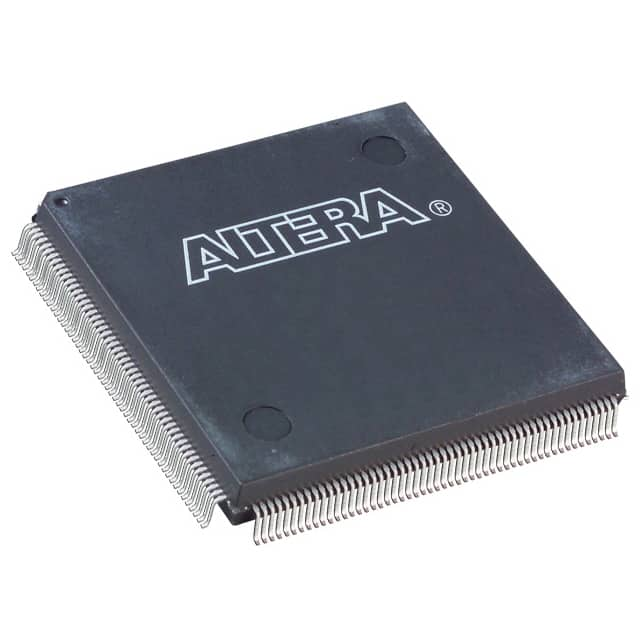EP1K30QC208-3
Product Overview
Category: Integrated Circuit (IC)
Use: The EP1K30QC208-3 is a programmable logic device (PLD) that belongs to the family of Altera's Cyclone series. It is designed for various digital applications, including data processing, control systems, and communication devices.
Characteristics: - High-performance PLD with low power consumption - Offers high-speed performance and flexibility in design - Provides reconfigurable logic elements and embedded memory blocks - Supports various I/O standards for easy integration into different systems
Package: The EP1K30QC208-3 comes in a Quad Flat Package (QFP), which provides a compact and reliable form factor for easy installation on circuit boards.
Essence: This PLD is built using advanced semiconductor technology, allowing it to perform complex logic functions efficiently. It offers a cost-effective solution for implementing custom digital designs.
Packaging/Quantity: The EP1K30QC208-3 is typically sold in reels or trays, containing multiple units per package. The exact quantity may vary depending on the supplier.
Specifications
- Device Type: Programmable Logic Device (PLD)
- Family: Cyclone
- Model: EP1K30QC208-3
- Package Type: Quad Flat Package (QFP)
- Operating Voltage: 3.3V
- Number of Logic Elements: 30,000
- Number of Embedded Memory Blocks: 288
- Maximum Frequency: 200 MHz
- I/O Standards: LVCMOS, LVTTL, SSTL, HSTL, LVDS, etc.
- Operating Temperature Range: -40°C to 85°C
Detailed Pin Configuration
The EP1K30QC208-3 has a total of 208 pins, each serving a specific function in the device's operation. The pin configuration includes input/output pins, power supply pins, ground pins, and configuration pins. For a detailed pinout diagram and description, refer to the manufacturer's datasheet.
Functional Features
- Reconfigurable Logic Elements: The EP1K30QC208-3 offers a large number of logic elements that can be programmed to perform various digital functions.
- Embedded Memory Blocks: It includes embedded memory blocks that can be used for data storage or implementing complex algorithms.
- Flexible I/O Standards: The device supports multiple I/O standards, allowing easy integration with different systems.
- Low Power Consumption: The PLD is designed to operate efficiently with low power consumption, making it suitable for battery-powered applications.
Advantages and Disadvantages
Advantages: - High-performance and flexibility in design - Cost-effective solution for custom digital designs - Wide range of supported I/O standards - Low power consumption
Disadvantages: - Limited number of logic elements compared to higher-end models - May require additional components for certain applications
Working Principles
The EP1K30QC208-3 operates based on the principles of programmable logic. It consists of configurable logic elements and embedded memory blocks that can be programmed using hardware description languages (HDL) or graphical design tools. The device's internal architecture allows users to define the desired logic functions and interconnections, enabling the implementation of complex digital circuits.
Detailed Application Field Plans
The EP1K30QC208-3 finds applications in various fields, including: - Industrial automation and control systems - Communication devices and networking equipment - Data processing and storage systems - Automotive electronics - Medical equipment - Consumer electronics
Its versatility and performance make it suitable for a wide range of digital applications.
Detailed and Complete Alternative Models
- EP1K50QC208-3: Similar to EP1K30QC208-3 but with 50,000 logic elements
- EP1K100QC208-3: Similar to EP1K30QC208-3 but with 100,000 logic elements
- EP2K30QC208-3: A newer model with enhanced features and improved performance
These alternative models offer different levels of logic capacity and may better suit specific project requirements.
Word count: 512 words
Senaraikan 10 soalan dan jawapan biasa yang berkaitan dengan aplikasi EP1K30QC208-3 dalam penyelesaian teknikal
Sure! Here are 10 common questions and answers related to the application of EP1K30QC208-3 in technical solutions:
1. What is EP1K30QC208-3? EP1K30QC208-3 is a specific model of Field Programmable Gate Array (FPGA) manufactured by Altera (now Intel). It is designed for various applications in digital logic design and embedded systems.
2. What are the key features of EP1K30QC208-3? EP1K30QC208-3 offers 30,000 logic elements, 208-pin Quad Flat Package (QFP), 3.3V operation, and various I/O capabilities. It also includes built-in memory blocks, PLLs, and other resources for implementing complex designs.
3. What are some typical applications of EP1K30QC208-3? EP1K30QC208-3 can be used in a wide range of applications such as industrial automation, telecommunications, medical devices, automotive electronics, aerospace systems, and many more.
4. How can EP1K30QC208-3 be programmed? EP1K30QC208-3 can be programmed using Hardware Description Languages (HDLs) like VHDL or Verilog. Designers write code that describes the desired functionality, which is then synthesized and loaded onto the FPGA using specialized software tools.
5. Can EP1K30QC208-3 be reprogrammed? Yes, EP1K30QC208-3 is a reprogrammable FPGA. This means that after programming, the device can be erased and reprogrammed with a different design or updated version of the same design.
6. What are the advantages of using EP1K30QC208-3 in technical solutions? EP1K30QC208-3 provides flexibility, high performance, and scalability. It allows designers to implement custom logic functions, accelerate processing tasks, and adapt to changing requirements without the need for dedicated hardware.
7. What are the power requirements for EP1K30QC208-3? EP1K30QC208-3 operates at a voltage of 3.3V. The power consumption depends on the design complexity and utilization of the FPGA resources.
8. Can EP1K30QC208-3 interface with other components or devices? Yes, EP1K30QC208-3 supports various I/O standards such as LVCMOS, LVTTL, SSTL, LVDS, and more. This allows it to interface with different components and devices like sensors, memory modules, communication interfaces, and displays.
9. Are there any limitations or considerations when using EP1K30QC208-3? Designers should consider factors like power consumption, heat dissipation, timing constraints, and resource utilization while using EP1K30QC208-3. Additionally, complex designs may require careful planning and optimization to fit within the available resources.
10. Where can I find additional resources and support for EP1K30QC208-3? You can refer to the official documentation and datasheets provided by Intel (formerly Altera) for detailed information about EP1K30QC208-3. Additionally, online forums, communities, and application notes can be valuable sources of support and knowledge-sharing.


